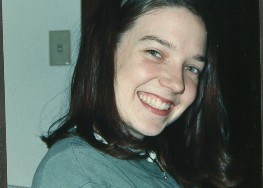| Text
of a talk given in the fall of
2004 to an audience of about 500 incoming medical students and their
parents
by Hawthorne’s Oncologist Joanna Cain, MD, Professor and Chair, Ob/Gyn; Director, Center for Women's Health at Oregon Health & Science University:
White Coat Ceremony1
Talk 2004: Joanna M. Cain
You enter today,
with the donning of your white coat, a company of healers that practice
an art that has one foot in ancient precepts of the art of medicine and
one foot in the most technologically advanced therapies imaginable. You
are committed to assuring the benefit of patients — the ethical
principle
of beneficence — and your success will be measured in whether or not —
with each patient you see for the rest of your career — you achieve a
goal
of medicine. Those are worthy goals! They are the goals of restoring
health,
relieving symptoms, restoring function or maintaining compromised
function,
saving or prolonging life, education and counseling of patients about
their
condition and prognosis and avoiding harm to the patient in the course
of care (Nonmalificence).
You will always,
from now on, have one foot solidly in science and one foot solidly in
the
art of medicine. Donning this coat brings you into a world where
sometimes
the BEST treatment you can offer is your healing presence for the
patient
and her family…not the next advance in technology or latest
chemotherapy.
Your patients will look to you , in your symbolic white coat, for bridging
the gap between the science and the art of medicine.
Let me tell you about
a special patient. Hawthorne was a patient of mine
who brought
this paradox of medicine continually to mind. She was a young, talented
graphic artist working with the premiere marketing firm in the NW. She
produced books, logos, and had friendships all over the Portland area —
from the most elite to the dishwashers at her favorite restaurants. She
was a bright light to everyone around her — full of quirky perspectives
and viewpoints that livened everything around her. Knowing her was a
gift
— to each of us who had that privilege.
She had ovarian cancer
that would not respond to the most advanced, or protocol therapies we
could
devise. Every choice we made was weighed one way with the latest in
gnomic
and proteinomic information and another way with her quality of life —
because she was determined to live every moment of her life fully —
even
though she knew she would die of this disease. Our conversations
focused
on both what she had read about a certain chemotherapy and also how
much
this great new idea would “cost” in terms of side effects, whether or
not
she could continue her creative work, how tired she would be.
Her family thinks she
had wonderful care, now that she did die at home and her special light
is lost to us. It was not
the meticulous, logical, evidence based
care or the high tech stays in the ICU that ultimately made a
difference
to them — or to Hawthorne. It was the listening to who she was, what
she
wanted and doing the best we could with the imperfect tools of medicine
we had to make that happen for her, for as long as we could. It was
about
the healing touch and the listening ear — not just the data that we
could
spout. Being a physician is all these things — and it is often going
beyond
the “prognosis” to heal what we can, to bring comfort, and to be
present.
We gave a family the gift of their daughter’s ability to “control” her
disease and to be herself as much as we imperfectly could. In doing so,
we helped them and ourselves begin to heal as well.
Al Jonsen, a famous contemporary bioethicist, says “every clinical decision is an ethical decision as well, made in the light both of facts and of values.” The very best physicians have a foot in the two worlds, actively seeking the most current information and the most advanced therapeutic choices while balancing those with the person in front of them, and their special needs, desires, and hopes. That special privilege to walk a healing journey with our patients — to a cure or to better health with disease or to a death with triumph of the spirit and person is ours uniquely. It begins here today for you with your symbolic white coat. There are ever greater challenges ahead for us all in medicine that will draw on both these roots of medicine. How we manipulate the new tools of genomics and proteinomics as a society and a profession? How we deal with commercialism or our present medical structure that leaves so many without access to care? How we allocate resources including that scarce commodity — our time — when there is a scarcity of physicians. Answering these broad social issues of medicine, like caring for your individual patient, invokes the same need to keep one foot firmly in the science and one foot firmly in the art of medicine. You are a generation that will need to answer questions about what is just and fair in medicine, the generation that must as Edmund Pellegrino (another contemporary bioethicist) puts it “examine the past sources of medical morality for what is perennially true, for what must be replaced, and what needs refurbishing but is still applicable. Illness and healing (he says) are… grounded in our humanity, a humanity we share with our predecessors and which our successors will share with us.” You are a critical link in the long line of healers. In the pocket of your white coat is a card from one of your predecessors, someday YOUR card will be in a new students coat -- your successor. One of our rather well known predecessors, Aristotle, wrote that : “To know how actions must be performed and distributions made in order to be just is a harder task than to know what makes (people) healthy.. where it is easy to know what drugs, cautery and surgery are but to know HOW to administer them, to whom and when, in order to make the patient healthy, is the truly difficult task of being a physician. ”Judgment and balance are the hallmarks of the white coat you will wear. So, even for these broader challenges facing you — having one foot in science and one in the art of medicine will serve you well. ir Thomas Percival writing in 1790, another predecessor who wrote the first true book on medical ethics felt that “no profession is more favorable, than that of medicine, to the formation of a mental constitution, which unites in it very high degrees of intellectual and moral vigor; because it calls forth the steady and unremitting exertions of benevolence, under the direction of cultivated reason; … He understood the dual nature of medicine that you inherit. We ask a great deal of you today, in asking that you firmly keep on foot in science and one in the art of medicine — but you follow in great footsteps, on a path that leads us into a future of measured and humane medicine. e are honored to be teachers and colleagues in this beginning for you, and delighted to have you join this rare and specially privileged profession. 1The White Coat Ceremony, established by Dr. Arnold Gold at Columbia University Medical School in 1993, was designed to impress upon students, physicians and the public the important symbolic role of the white coat in patient-doctor interactions. Gold argued that students were reciting the Hippocratic Oath four years too late-upon their graduation from medical school. He felt the oath and the conferring of white coats would be better done at the start of medical school, when students receive their first exposure to clinical medicine. The White Coat Ceremony provides a mechanism by which values that are key to the medical profession can be openly articulated and carefully considered in the company of peers, parents, partners and faculty. |

